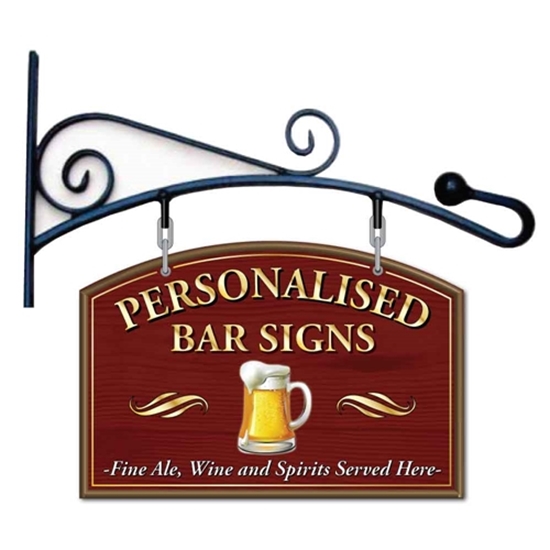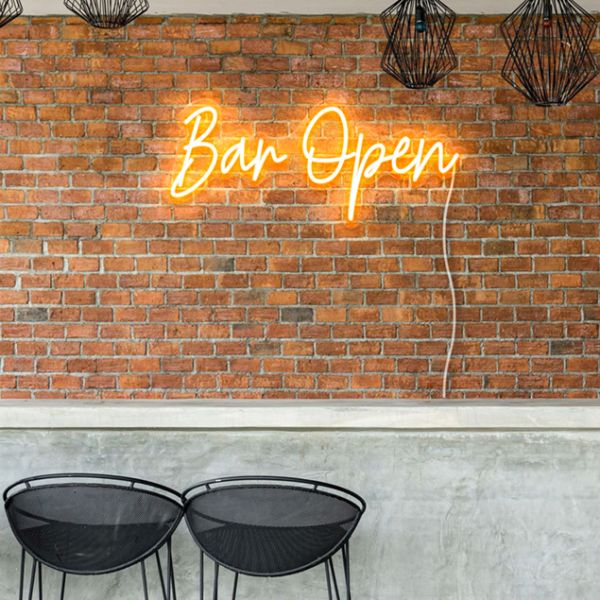Handy Facts For Selecting Man Cave Signs
Handy Facts For Selecting Man Cave Signs
Blog Article
What Is The Difference Between Size Of The Bar Sign?
Bar signs differ in size and style based on their purpose, placement and overall aesthetic. The following are the ways that different sizes influence bar signs with regard to function and style. The Big Sign
Draw attention and become as a focal point.
Uses for: Exterior branding, main brand signs or feature walls.
Placement: It is typically placed above entrances, large walls or outside of the bar. It can draw patrons.
Examples include huge neon signs in vintage-style and large-sized murals and large vintage signs.
2. Medium Signs
The purpose of the wall art is to provide details and improve decor not taking up space.
Uses: Menu boards and directional signage.
Location: Located in a position that is easy to view, but not overpowering, such as behind the bar, over seating areas, or on feature walls.
A few examples are signs of medium size for daily specials; steel signs with a bar's logo, or themed decorative signs.
3. Small Signs
To add subtle decorative particulars and/or aspects.
They can be used for table signs as well as small decorative objects or labels.
Placement : on tables or on shelves in which close-up viewing is required.
Examples include table number signs or small framed quotes.
Size Aspects
Visibility
Large signs are designed to attract the attention of people passing by, and establish the bar’s presence.
Medium Signs: These signs are ideal for balancing visibility with space efficiency and providing important information without overwhelming décor.
Small signs are ideal for providing information with close proximity and intimate specifics. This can enhance the user experience.
Proportion
Large Signs: They should be proportionally large in order to prevent overwhelming smaller spaces. The ideal choice for large or open areas.
Medium Signs - Fits in easily with any interior and can be used in a variety of positioning.
Small signs: Ideal to add details and fit into smaller spaces with less clutter.
Impact
Large-sized signs: They can make an impressive statement. they can also serve to create a brand. Commonly used to establish the tone for the bar.
Medium Signs: Creates the perfect balance between decoration and visibility, all while providing crucial information.
Small Signs : These signs add detail and charm, creating a rich and layered visual experience.
Practicality
Large Signs: These sign require a large amount of mounting equipment, and are also more expensive because of their dimensions.
Medium signs offer more flexibility when it comes to design, and are also easier to put up.
Small Signs: Easy to replace and update, they are perfect for dynamic settings like bars where menus or promotions alter frequently.
Functionality
Large Signs: Primarily functional to draw attention and increase visibility.
Medium Signs that are both functional and decorative, providing essential information while enhancing the aesthetic.
Small Signs can be used to provide detailed information. They can also be utilized to enhance the look of your theme.
The ideal size for bar signage is determined by their intended use, the layout, as well as the impact they have on patrons. Be sure to keep these aspects in mind so that the signs contribute to the atmosphere of the bar as well as the operational requirements of the bar. Follow the top rated this site on bar sign for more info including modern pub sign, personalised pub signs for sale, personalised home bar signs, home bar pub signs, pub signs made, hanging pub signs for sale, personalised signs for home bar, personalised pub signs for sale, personalised outdoor bar signs, pub signs to buy and more.
What Is The Difference Between Bar Signs And Other Signs Regarding Light?
Bar signs vary significantly when it comes to lighting. It affects their ambiance and visibility and overall impact. Here are some of the most significant ways lighting impacts bar signs. Neon signs
Characteristics: Bright, colorful, classic.
Lighting: Utilizes gas tubes with neon-filled gas that emit illumination when they are electrically charged.
Uses : Perfect for creating an aged, retro-style look. Useful for bar names and logos.
Advantages: It's highly visible from an extended distance.
Advantages: They can be damaged and be costly to fix.
2. LED Signs
Characteristics: Energy-efficient, versatile, modern.
Lighting LEDs: Light-emitting Diodes (LEDs), which produce bright, vibrant and glowing light.
Applications: It can be used for indoor or outdoor signs, and also programmable displays.
Benefits: The LEDs last a long time, are efficient in energy use, and are programmable with animations or changes in color.
Negatives: It can be costly initially, but can save on energy and maintenance costs.
3. Backlit Signs
Characteristics: Elegant, sophisticated, subtle.
Lighting: A transparent surface is illuminated with LEDs or fluoro lights to create an ethereal glowing.
Usage: Most often used on modern bar signs, menu boards, and branding elements.
Benefits Pros: A professional and neat look is provided, enhancing the readability in dim lighting.
Some disadvantages include a more difficult installation process and higher costs upfront.
4. Signs for Edge-Lit
Characteristics: Sleek, contemporary, stylish.
Lighting: Lights up the edges of an acrylic sign panel.
It is a good choice for modern design, minimalist.
Advantages Creates a sophisticated and distinct look.
Disadvantages: Limited to specific style of design.
5. Ambient/Accent Lighting
Characteristics: Subtle, atmospheric, decorative.
Lighting: Uses indirect sources of light to emphasize and highlight the signage.
Uses for this product: It enhances the ambience and is frequently used to highlight themes in decor or art.
Benefits: Creates a cozy and warm environment.
Negatives
6. Marquee signs
Characteristics: Bold, theatrical, eye-catching.
Lighting: Make use of multiple LEDs and lights to illuminate the sign.
Uses: Signs on the outside for event promotions, as well as vintage-style cinema are popular.
Benefits: High visibility and attention grabbing.
Disadvantages include: High cost and regular maintenance.
7. Projection Signs
Characteristics: Dynamic, innovative, versatile.
Lighting Projectors project light and images on a surface.
Uses: Ideal for promotional occasions, temporary displays, and other dynamic displays.
Advantages: Easy to change No physical structure is required.
Disadvantages
8. Fluorescent Signs
Characteristics: Bright, cost-effective, traditional.
Lighting: Uses fluorescent tube to give light.
Typically used to create larger indoor or outdoor signs.
Benefits: Bright and efficient for large signage, inexpensive.
Advantages
Lighting Things to Consider
Visibility
Neon signs and LEDs can be extremely effective in grabbing the attention of people, especially in low-light situations.
Backlit and Edge-Lit Signs are great for improving visibility and creating a polished look.
Energy Efficiency
LED signs: Energy-efficient and long-lasting.
The signs in neon and fluorescent Neon is not as energy efficient.
Aesthetic Appeal
Neon Signs and Marquees They are perfect for retro and vintage style.
Edge-lit and Backlit Signs are great for contemporary designs.
Ambient lighting: It improves the ambience and overall mood.
Maintenance
LED Signs last and are low-maintenance.
Neon and fluorescent signs require regular maintenance and repair.
Cost
LED Backlit Signs - Higher initial costs but lower ongoing expenses
Fluorescent Signs: Lower initial cost, but more expensive long-term energy costs.
Flexibility
The flexibility of LED signs and projections permits for changing and dynamic content.
Traditional Signs: They're more rigid, however they usually achieve a certain style.
By selecting the right kind of lighting and color the bar proprietors can enhance the visibility of their establishment, create an ideal atmosphere and also effectively communicate the brand and advertising messages. Follow the top rated cocktail bar sign for website tips including to the pub sign, pub signs made, personalised beer sign, personalised metal pub signs, design your own bar sign, hanging home bar signs, bar sign design, home garden bar signs, personalised outdoor pub signs, outdoor personalised bar sign and more.
What Is The Difference Between Bar Signs From Regulations?
The bar sign is subject to different regulations, which are imposed by local as well as federal and state authorities, to ensure the health of the public, aesthetic standards as well as compliance with the regulations on zoning, and to ensure public welfare. The regulations for bar signs differ. Size and Positioning Regulations
Zoning Laws and Regulations define the place of signs, their dimensions and height, as well their distance from roads, neighboring buildings, or property boundaries.
Historical Districts. Signs of all sizes, styles, and materials may be prohibited to protect the historical character.
2. Illumination Restrictions
Light Pollution Regulations can limit the brightness and color of illuminated signs to protect the atmosphere at night and limit light pollution.
Safety Considerations: Signs must not cause glare or distract which could pose a risk to drivers or pedestrians, particularly near roads.
3. Signage content
Alcohol Advertising: Alcohol advertisements are prohibited in some jurisdictions. They are prohibited from using images or content that may be appealing to minors or promote excessive drinking.
Health Warnings - Laws may require the posting of health warnings on the signs pertaining to smoking or drinking alcohol.
4. Historic Preservation Regulations
Signs in historical districts must be in harmony with the architectural style or design of the area. This requires the approval of preservation boards.
Materials and Design Restrictions could be applied to the materials, design, and color schemes of signs in order to preserve historical integrity.
5. Sign Permitting Process
Permits are needed: The owners of bars must get permits to set up or alter signage. This could include submitting drawings, paying for fees, as well getting approval from local authorities.
Code Compliance: Signs need to comply with building codes and fire safety regulations as also accessibility standards to maintain public safety and ensure accessibility for people with disabilities.
6. Maintenance of Signs and Removal
Maintenance Requirements Owners of bars need to keep signs in good shape, ensure they are sturdy and free of hazards. They also need to be compliant with the regulations.
Abandoned Signs: Regulations may be enacted to remove signs that are abandoned or damaged to avoid blight while conserving the aesthetics of the area around it.
7. Digital Signage Regulations
Content Restrictions There are laws which regulate the content of digital signs. They can ban certain types of content, such as disturbing images or lights that flash.
Limitations on the Operational Signs To reduce visual clutter, laws may restrict the luminosity of digital signs, their movement or frequency of change.
8. Enforcement and Penalties
Inspections: Local authorities inspect signs periodically to make sure they're in compliance the regulations for signage. They will issue citations when violations are found.
Penalties: Penalties may include fines and court orders, as well as orders for signs to be removed or modified and legal action.
9. Sign Variance Process
Bar owners can apply for Variances: Bar owners may apply for variances in order to depart from the regulations for signs that apply to all establishments. They must prove that they have a legitimate reason to do so and limit any negative effects on aesthetics or safety.
Public Input: Variances may require public hearings, or input from community members neighbors, property owners who own adjacent properties, or business associations.
10. Community Engagement and input from the community
Public Consultation: Some areas involve residents in the design of signage regulations through public meetings, surveys, or stakeholder meetings.
Sign regulations could have community Benefits. Sign regulations could include provisions that enhance the appearance of signs, promote local businesses, or revitalize neighborhoods.
By knowing and observing signs regulations, bar owners can ensure that their signage enhances the appearance of their establishment, contribute positively to the surrounding community, and comply with legal requirements, while reducing the risk of fines or penalties, as well as legal battles. Follow the top helpful hints for blog recommendations including bar signs for garden, garden bar sign personalised, signs for garden bar, bar pub signs, pub sign design ideas, personalised cocktail sign, pub signs for home bars, bar signs for garden, personalised pub signs, personalised bar signs and more.